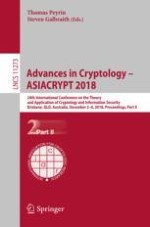2018 | OriginalPaper | Buchkapitel
How to Securely Compute with Noisy Leakage in Quasilinear Complexity
verfasst von : Dahmun Goudarzi, Antoine Joux, Matthieu Rivain
Erschienen in: Advances in Cryptology – ASIACRYPT 2018
Aktivieren Sie unsere intelligente Suche, um passende Fachinhalte oder Patente zu finden.
Wählen Sie Textabschnitte aus um mit Künstlicher Intelligenz passenden Patente zu finden. powered by
Markieren Sie Textabschnitte, um KI-gestützt weitere passende Inhalte zu finden. powered by
